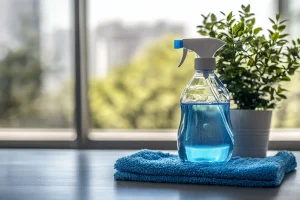1. The Enduring Radiance of Gold and the Art of Its Preservation
Gold jewelry holds a unique allure, a testament to its historical significance as a symbol of beauty, wealth, and deeply personal sentiments. Beyond its monetary worth, gold often carries significant emotional value, transforming pieces into cherished heirlooms and markers of life’s special moments. This profound connection makes the proper care and preservation of gold jewelry not just a matter of maintenance, but an act of cherishing memories.
Over time, even the most radiant gold pieces can lose their luster. Daily wear exposes jewelry to a barrage of substances – oils from the skin, lotions, cosmetics, and environmental pollutants – that accumulate, creating a film that dulls its natural shine. Safe and appropriate cleaning is therefore essential, not only to restore this brilliance but also to prevent potential long-term damage. Improper cleaning techniques, such as using harsh chemicals or abrasive materials, can lead to scratches, discoloration, or even compromise the structural integrity of the metal and any set gemstones.
Contact us!
The act of cleaning jewelry, then, transcends mere aesthetics; it is a crucial form of preventative maintenance. The accumulation of dirt and grime is not just unsightly; these particles can be surprisingly abrasive. If left unaddressed, they can cause micro-scratches on the gold’s surface, particularly on softer, higher-karat gold.
Furthermore, this buildup, especially around gemstone settings, can trap moisture or corrosive substances, potentially weakening prongs or adversely affecting the gemstones over time. Thus, regular, gentle cleaning mitigates these risks, effectively extending the jewelry’s lifespan far beyond simply keeping it shiny.

The emotional significance often attached to gold jewelry further elevates the importance of employing safe cleaning practices. These pieces are frequently gifts marking significant life events or are passed down as heirlooms, imbuing them with a sentimental weight that often surpasses their material value. Consequently, any damage incurred from improper cleaning—such as the use of harsh chemicals that can corrode alloys or harm delicate stones —represents not just a material loss but can also be a source of considerable emotional distress.
2. Know Your Gold: A Foundation for Safe and Effective Cleaning
Before embarking on any cleaning regimen, understanding the specific type of gold your jewelry is made from is paramount. Gold’s composition—its purity, color, and whether it’s solid, filled, or plated—fundamentally dictates its resilience and the appropriate care it requires. This knowledge is not merely for aesthetic appreciation or budget considerations but forms the very foundation of a safe and effective long-term care strategy.
Understanding Gold Purity (Karats): Impact on Care
The purity of gold is measured in karats (K). Pure gold is 24K, but because it is a very soft metal, it’s often alloyed with other metals like silver, copper, zinc, and nickel to enhance its hardness and durability for jewelry making.
- 24K Gold: Being pure gold, it is the most resistant to tarnish but also the softest and most susceptible to scratches and bending. It demands extremely gentle handling and cleaning methods.
- 22K, 18K, 14K, 10K Gold: These common jewelry karats contain a higher proportion of alloying metals. While this increases durability, these alloys can sometimes react with chemicals or be more prone to tarnishing compared to purer gold, especially if not cared for properly. Generally, the lower the karat number, the harder and more durable the alloy, but also potentially more susceptible to reactions from the non-gold metals present. For instance, 10K gold contains a significant percentage of other metals, which might make it more prone to tarnish than 18K gold under certain conditions.
The presence of these alloys is a double-edged sword. While they impart necessary strength and allow for a wider range of jewelry designs, they also introduce vulnerabilities that pure gold largely avoids. Pure gold (24K) is highly resistant to tarnish.
However, the alloying metals—especially copper and silver—are more reactive to environmental factors like sulfur compounds in the air, moisture, and chemicals such as chlorine , leading to the potential for tarnish. This creates a paradox: the elements added for strength also introduce a chemical susceptibility. This underscores why even “gold” jewelry requires careful cleaning, primarily to manage the behavior of its non-gold components.
The Spectrum of Gold Colors: Cleaning Nuances
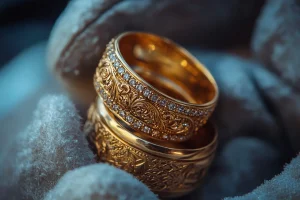 The color of gold is determined by the specific metals used in its alloy.
The color of gold is determined by the specific metals used in its alloy.
- Yellow Gold: This is the most traditional color, typically achieved by alloying pure gold with silver and copper. It can be cleaned using standard mild soap methods and requires regular polishing to maintain its characteristic shine.
- White Gold: To achieve its silvery-white appearance, pure gold is alloyed with white metals such as palladium, nickel, or silver. Critically, most white gold jewelry is then plated with rhodium, a hard, bright white metal from the platinum group, to give it a brilliant, durable finish. This rhodium plating is not permanent and wears off over time, especially with frequent wear or abrasive cleaning, revealing the slightly yellowish or grayish tint of the underlying white gold alloy. Professional re-plating is necessary periodically—often every few years, depending on wear—to maintain its bright white appearance. Abrasive cleaning methods will significantly accelerate the wear of this plating.
- Rose Gold: This popular hue is created by incorporating a higher percentage of copper into the gold alloy. The copper content makes rose gold very durable, often more so than yellow or white gold. Over time, the copper may cause the jewelry to develop a subtle patina, a characteristic darkening or color change that some find desirable as it adds to the vintage appeal. Like yellow gold, it benefits from regular polishing to maintain its luster.
Distinguishing Gold Types: Solid Gold, Gold-Filled, and Gold-Plated
The construction of the jewelry piece also significantly influences cleaning methods.
- Solid Gold: This term refers to jewelry made entirely of a gold alloy throughout the piece (e.g., 14K solid gold). It is the most durable and valuable type. Cleaning methods should be chosen based on the karat purity and any gemstones present, but generally, it can withstand standard gentle gold cleaning techniques.
- Gold-Filled: Gold-filled jewelry has a much thicker layer of gold—typically 5% or 1/20 of the total weight—mechanically bonded with heat and pressure to a base metal core (often brass or sterling silver). This makes it more durable and valuable than gold-plated jewelry, with a gold layer that can last for many years with proper care. It can generally be cleaned gently with mild soap (like Dawn dish soap) and water. Avoid harsh abrasives or excessive scrubbing, and do not soak for excessively long periods, especially if there are concerns about adhesives in vintage pieces.
- Gold-Plated: Gold-plated jewelry features a very thin layer of gold electroplated onto a base metal (such as copper or brass). This gold layer is susceptible to wearing off quickly with friction, exposure to chemicals, or abrasive cleaning. It requires the most delicate cleaning approach. To clean gold-plated items, use only a soft cloth, perhaps very slightly dampened with water, or an extremely mild soap solution, and wipe very gently. Avoid any scrubbing, brushes, or abrasive materials. It is crucial to dry gold-plated jewelry immediately and thoroughly after any exposure to moisture to prevent tarnishing of the base metal if the plating is compromised.
The specific type of gold—be it 24K’s softness demanding utmost gentleness , white gold’s rhodium plating necessitating a unique re-plating cycle , or the thinness of gold plating making it highly vulnerable to wear —is a primary determinant of its care regimen. Understanding these distinctions is a prerequisite for selecting appropriate cleaning methods and managing expectations for the jewelry’s durability and long-term maintenance.
3. Assembling Your Home Gold Cleaning Arsenal: The Right Tools and Agents
 Having the correct tools and cleaning agents on hand is crucial for cleaning gold jewelry safely and effectively at home. The industry-wide consensus leans heavily towards simple, readily available household items, underscoring gold’s vulnerability to abrasion and harsh chemicals.
Having the correct tools and cleaning agents on hand is crucial for cleaning gold jewelry safely and effectively at home. The industry-wide consensus leans heavily towards simple, readily available household items, underscoring gold’s vulnerability to abrasion and harsh chemicals.
Gentle and Effective Cleaning Agents
- Mild, Phosphate-Free Dish Soap: This is almost universally recommended as the safest and most effective primary cleaning agent for most gold jewelry. Brands like Dawn are frequently cited as suitable options. The specific recommendation for “phosphate-free” dish soap suggests a preference for formulations less likely to leave residues or cause unforeseen reactions with alloys or gemstones, possibly reflecting a more nuanced understanding of chemical interactions and environmental considerations.
- Baby Shampoo: For extremely delicate items or if there’s a concern about the mildness of dish soap, baby shampoo serves as a gentle alternative. It typically contains fewer harsh chemical agents.
- Specialized Commercial Jewelry Cleaners (Use with Caution): If opting for a commercial cleaner, it is imperative to ensure it is specifically formulated for gold and any gemstones present in the jewelry. Always scrutinize the ingredient list for harsh chemicals like ammonia or alcohol, especially when dealing with delicate or treated gemstones. Some commercial cleaners may contain ammonia, which can be problematic for certain stones. The Gemological Institute of America (GIA) advises checking ingredients and avoiding products with chlorine, bleach, or abrasives.
The Right Implements
- Soft-Bristled Toothbrush: Essential for gently dislodging loosened dirt, particularly from crevices and intricate designs. A new baby toothbrush or a brush specifically designed for jewelry is ideal due to its exceptionally soft bristles. It is important to avoid using old toothbrushes, as residual toothpaste can be abrasive and damage gold.
- Microfiber Cloths: These are excellent for drying and polishing gold jewelry because they are non-abrasive and lint-free, preventing scratches and leaving no fibers behind.
- Lint-Free Cloths: This is a broader category of cloths that do not shed fibers; microfiber is a prime example. These are suitable for drying and gentle wiping.
- Small Bowl: A non-metallic bowl (ceramic or glass is good) is needed for mixing the cleaning solution and soaking the jewelry.
Specialized Aids
- Jeweler’s Polishing Cloth: This is a specially treated cloth designed to remove tarnish and impart a high shine as a final polishing step. These cloths often feature a two-part system: an inner layer treated with micro-fine polishers for cleaning and tarnish removal, and an outer layer for buffing. The treated inner layer should not be washed, as this would remove the polishing agents. These are best for occasional use on solid gold pieces to enhance luster.
The consistent recommendation of these simple tools signifies a well-established understanding that complex or harsh solutions are generally unnecessary and pose greater risks for routine home cleaning of gold. The “keep it simple” approach, focusing on chemically mild and physically non-abrasive methods, is demonstrably the safest path.
4. The Cornerstone of Care: A Step-by-Step Guide to Cleaning Plain Gold Jewelry
The following systematic process is designed to maximize cleaning effectiveness while minimizing any risk to your plain gold jewelry. Each step plays a role in gently removing grime and restoring shine, respecting the material’s properties.
Preparing Your Workspace and Jewelry
Before you begin, set up a clean, well-lit area. Lay down a soft towel or cloth on your work surface to protect both the jewelry and the surface. A crucial safety measure, especially if working over a sink, is to always use a separate bowl for your cleaning solution or ensure the sink drain is securely covered with a cloth or stopper. This simple precaution can prevent the heartbreaking accidental loss of small or slippery items down the drain. It’s also wise to inspect your jewelry for any pre-existing issues like loose stones or visible damage before cleaning. If you notice any problems, it’s best to postpone home cleaning and consult a professional jeweler, as the cleaning process could exacerbate existing damage.
The Soaking Solution: Loosening Grime
 Fill a small bowl with warm water. It’s important to use warm, not hot or boiling, water. Warm water effectively helps dissolve grease and loosen accumulated dirt. Hot water, conversely, poses risks, including potential thermal shock to certain gemstones (if present, even in “plain” gold items like some wedding bands with small accent stones) and expansion of the metal, which could loosen settings. Using similar water temperatures for both cleaning and rinsing is also advisable to protect any accompanying gemstones from drastic temperature changes.
Fill a small bowl with warm water. It’s important to use warm, not hot or boiling, water. Warm water effectively helps dissolve grease and loosen accumulated dirt. Hot water, conversely, poses risks, including potential thermal shock to certain gemstones (if present, even in “plain” gold items like some wedding bands with small accent stones) and expansion of the metal, which could loosen settings. Using similar water temperatures for both cleaning and rinsing is also advisable to protect any accompanying gemstones from drastic temperature changes.
Add a few drops of a mild, phosphate-free dish soap (such as Dawn) or a gentle baby shampoo to the warm water. Stir gently to create a sudsy solution. Immerse your gold jewelry in this solution and allow it to soak for approximately 10 to 20 minutes. For particularly dirty pieces, this soaking time can be extended; some sources even suggest an overnight soak for certain solutions, although 10-20 minutes is typically sufficient for regular cleaning. This soaking stage is vital as it softens and loosens adherent grime, thereby reducing the need for more aggressive mechanical action later.
The Gentle Scrub: Dislodging Stubborn Dirt
After the jewelry has soaked, use a new, soft-bristled toothbrush—a baby toothbrush is ideal for its gentleness—to carefully scrub the piece. Focus your attention on intricate details, crevices, around clasps, and underneath any settings where dirt and grime tend to accumulate.
Employ gentle, circular motions. It is critical to avoid aggressive or hard scrubbing. Gold is a relatively soft metal, particularly in higher karats or if it’s gold-plated, and can be easily scratched. The repeated emphasis on “gentle” handling throughout the cleaning process underscores that mechanical damage, such as scratches from excessive force or slightly too abrasive materials, is often the primary risk in home gold cleaning, assuming benign cleaning agents are used.
The Critical Rinse: Removing All Traces of Soap
Once you’ve gently scrubbed the jewelry, rinse it thoroughly under a stream of lukewarm running water. This step is critical to ensure all soap residue is completely washed away. Leftover soap film can make the gold appear dull and can actually attract more dirt, counteracting your cleaning efforts. Remember, if rinsing over a sink, keep the drain securely covered.
Drying to Perfection: Preventing Water Spots and Tarnish
After rinsing, gently pat the jewelry dry using a soft, lint-free, or microfiber cloth. Avoid using paper towels, as their fibers can be surprisingly abrasive and may scratch the gold.
For pieces with intricate designs or hard-to-reach areas where moisture might be trapped, allow the jewelry to air dry completely on a clean, soft towel before storing or wearing it. Ensuring the jewelry is fully dry is important not only to prevent water spots, which are an aesthetic concern, but also because residual moisture can contribute to the tarnishing of gold alloys over time.
5. Adorned with Gems: Specialized Cleaning for Gold Jewelry with Stones
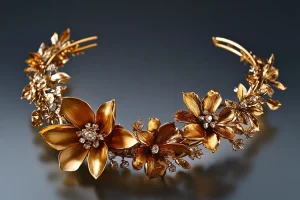 When gold jewelry is embellished with gemstones, the cleaning process requires additional care and consideration. The “safest” cleaning method often defaults to the needs of the most delicate component—the gemstone—rather than what the gold itself might tolerate. Gold, while relatively soft, is chemically inert and generally handles mild soap and water well. However, many gemstones are highly sensitive to chemicals, moisture, heat, or mechanical stress.
When gold jewelry is embellished with gemstones, the cleaning process requires additional care and consideration. The “safest” cleaning method often defaults to the needs of the most delicate component—the gemstone—rather than what the gold itself might tolerate. Gold, while relatively soft, is chemically inert and generally handles mild soap and water well. However, many gemstones are highly sensitive to chemicals, moisture, heat, or mechanical stress.
Universal Precautions for Gemstone Jewelry
- Check Setting Security: Before every cleaning session, gently inspect the settings to ensure all stones are secure. Look for any loose prongs or stones that seem to wobble. If a stone is loose, do not proceed with home cleaning. The agitation, however gentle, could dislodge it. Instead, take the piece to a professional jeweler for repair.
- Know Your Gemstones: This cannot be overstated. Different gemstones possess vastly different physical and chemical properties, including hardness (measured on the Mohs scale), porosity, cleavage (tendency to split), and sensitivity to heat, chemicals, light, and various treatments. The Mohs scale of hardness, while a useful indicator, is not the sole determinant of a gemstone’s cleaning needs; porosity, cleavage, and treatments play equally critical roles. For example, diamonds are very hard (10 on Mohs scale ) but can still be damaged by impact along cleavage planes. Turquoise (Mohs 5-6 ) is not extremely soft, but its porosity makes it highly susceptible to damage from liquids and chemicals.
- Treated Gemstones: Many gemstones undergo treatments—such as oiling in emeralds , heat treatment in sapphires , or fracture filling in rubies—to enhance their color or clarity. These treatments can be compromised or even reversed by exposure to harsh chemicals, heat, or ultrasonic cleaners. The Gemological Institute of America (GIA) advises extreme caution when cleaning treated gems. Consumers may not always know if their gemstone is treated or the specific type of treatment used. This introduces a hidden vulnerability, as a cleaning method seemingly safe for an “untreated” version of a gemstone could damage a “treated” one. Therefore, the safest general advice for gemstone jewelry must assume the possibility of treatments and err on the side of caution.
- Porous Gemstones: Stones like pearls, opals, turquoise, coral, lapis lazuli, and malachite are porous. This means they can absorb liquids, including soapy water or chemical solutions, which can lead to discoloration, structural damage, or loss of luster. These gems require specific, often dry or minimally damp, cleaning techniques.
- When in Doubt, Consult a Jeweler: If you are uncertain about a gemstone’s identity, its treatment status, or the most appropriate and safe cleaning method, it is always best to seek the advice of a qualified professional jeweler.
Gemstone-Specific Cleaning Guide for Gold Jewelry
The following table provides guidance for cleaning common gemstones found in gold jewelry. This information is critical because a single cleaning method suitable for plain gold may be harmful to these diverse gemstones.
For example, the standard soap and water soak is detrimental to pearls and coral, and ultrasonic cleaners safe for some diamonds are disastrous for opals or emeralds.
| Gemstone Name | Key Characteristics | Safe Home Cleaning Method in Gold Setting | Critical Warnings & What to AVOID | When Professional Cleaning is Essential |
|---|---|---|---|---|
| Diamonds | Mohs Hardness: 10. Can have cleavage planes. May be fracture-filled. | Mild dish soap (phosphate-free) and warm water solution. Gently scrub with a very soft brush, especially under the stone and around settings. Rinse thoroughly with warm water. Pat dry with a lint-free cloth. | Harsh chemicals (bleach, chlorine), abrasive cleaners (toothpaste), sudden extreme temperature changes. Avoid ultrasonic/steam cleaners at home if unsure about stone integrity or if fracture-filled. | Heavy buildup, suspected damage to stone or setting, if known to be significantly fracture-filled. |
| Sapphires & Rubies (Corundum) | Mohs Hardness: 9. Durable but can be heat-treated or fracture-filled. | Mild dish soap and warm water solution. Soft brush for gentle scrubbing. Rinse well and dry with a soft cloth. | Harsh chemicals, ammonia-based cleaners (especially for sapphires ), extreme temperature changes. Avoid frequent ultrasonic use for rubies; occasional use for sapphires with caution. | If heavily soiled, if treatments are suspected and you’re unsure of stability, or if settings are loose. |
| Pearls (Organic) | Mohs Hardness: 2.5-4.5. Extremely porous, sensitive to acids, chemicals, heat, dehydration. | Never soak. Gently wipe each pearl with a soft, clean cloth dampened very slightly with lukewarm water (and perhaps a trace of extremely mild, phosphate-free soap if necessary, followed by wiping with a cloth dampened with plain water). Dry immediately with a soft, dry cloth. Lay flat to dry if strung, as wet silk can stretch. | ALL chemicals (perfumes, hairspray, household cleaners), acids (vinegar, lemon juice), abrasives, heat, ultrasonic cleaners, steam cleaners, soaking. | For restringing, deep cleaning, or if luster is significantly diminished. |
| Opals (Hydrated Silica) | Mohs Hardness: 5.5-6.5. High water content, prone to cracking/crazing from heat, sudden temperature changes, dehydration, impact, and pressure. Can be porous. | Gently wipe with a soft, damp cloth (lukewarm water). If necessary, use a very mild soap solution, rinse quickly with a damp cloth, and dry thoroughly immediately. Avoid soaking. | Harsh chemicals, detergents, oils, abrasives, ultrasonic cleaners, steam cleaners, hot water, dry heat, sudden temperature changes. Store with humidity in very dry climates. | If crazed, scratched, or for any concerns about stability or deep cleaning. |
| Emeralds (Beryl) | Mohs Hardness: 7.5-8. Often heavily included (internal fractures) and commonly treated with oils or resins to improve clarity. Sensitive to heat, pressure, and chemicals that can affect treatments. Can be brittle. | Use lukewarm water and a very mild soap. Do not soak. Gently wipe with a soft cloth or use a very soft brush on the gold setting, avoiding vigorous scrubbing of the emerald. Rinse quickly and pat dry carefully. | Harsh detergents, solvents (alcohol, acetone), oils (other than re-oiling by a professional), heat, ultrasonic cleaners, steam cleaners, sudden temperature changes, soaking. | If oil treatment needs refreshing, if heavily soiled, or if any damage is suspected. |
| Turquoise (Phosphate Mineral) | Mohs Hardness: 5-6. Porous, soft, sensitive to chemicals, oils, cosmetics, perspiration, heat, and sunlight (can cause discoloration). | Wipe gently with a soft, dry cloth. If necessary, use a cloth very slightly dampened with plain lukewarm water, then dry immediately and thoroughly. | Soaps, detergents, oils, all chemicals, abrasives, hot water, ultrasonic cleaners, steam cleaners. Avoid prolonged exposure to sunlight. | If discolored, stained, or for any significant cleaning needs. |
| Coral (Organic) | Mohs Hardness: 3-4. Very soft, porous, fragile. Sensitive to acids, chemicals, heat. | Never soak. Gently wipe with a clean cloth dampened only with lukewarm water. Dry thoroughly with a soft cloth. | All chemicals, acids, abrasives, hot water, ultrasonic cleaners, steam cleaners. | For any cleaning beyond a light wipe, or if damaged. |
| Lapis Lazuli, Malachite, Kunzite, Moonstone, Peridot, Tanzanite, Topaz, Zircon | Varying hardness (mostly 5-7.5). Sensitivities to heat, chemicals, acids, impact, or light vary. Many can be porous or treated. | Generally, the safest approach for these is a gentle wipe with a soft, dry or slightly damp cloth. For more durable ones (like Topaz, Zircon if untreated), very mild soap and lukewarm water with a soft brush can be used cautiously, followed by thorough rinsing and drying. | Avoid harsh chemicals, abrasives, ultrasonic cleaners (especially for Lapis, Malachite, Kunzite, Moonstone, Peridot, Tanzanite, Opal-like Topaz varieties), and extreme heat for most. Specific research per stone is vital. | If unsure of treatment or specific sensitivities, or for deep cleaning. |
This table consolidates complex, critical information into an easily scannable format, allowing users to quickly find their gemstone and understand its specific cleaning needs and warnings. This transforms generic advice into specific, actionable instructions, significantly enhancing the guide’s utility and authoritativeness.
6. Expanding Your Cleaning Knowledge: Advanced Tips, Cautious Alternatives, and Absolute No-Gos
 Beyond the basic soap and water method, understanding proactive care, the risks of certain alternative cleaners, and what to definitively avoid will ensure your gold jewelry remains in pristine condition for years to come.
Beyond the basic soap and water method, understanding proactive care, the risks of certain alternative cleaners, and what to definitively avoid will ensure your gold jewelry remains in pristine condition for years to come.
Proactive Care for Lasting Brilliance
Preventative measures are often as crucial as the cleaning process itself, minimizing the need for frequent or intensive cleaning and reducing wear and tear.
- Optimal Cleaning Frequency: The ideal cleaning frequency depends largely on how often the jewelry is worn. Pieces worn daily, like engagement rings or favorite necklaces, may benefit from a light cleaning every week or two to remove fresh buildup of oils and lotions. Items worn less frequently might only need cleaning every few months or when they appear visibly dull or dirty.
- Best Practices for Jewelry Storage: Proper storage is key to preventing scratches, tangling, and tarnish.
- Store each piece of jewelry separately, ideally in a fabric-lined jewelry box with individual compartments, soft pouches, or anti-tarnish bags. This prevents harder gemstones from scratching softer ones or metals.
- Keep jewelry away from excessive moisture and direct sunlight, as these conditions can promote tarnishing, especially in gold alloys containing silver or copper.
- When to Remove Jewelry: To protect your gold jewelry from damage and excessive buildup:
- Remove it before showering or bathing, as soap scum can accumulate and dull the finish.
- Take it off before swimming, especially in chlorinated pools or hot tubs. Chlorine is a harsh chemical that can damage or discolor gold alloys and some gemstones.
- Remove jewelry before using household cleaning products that may contain bleach, ammonia, or other harsh chemicals.
- It’s wise to remove jewelry before exercising to avoid contact with sweat (which can be acidic) and to prevent physical damage.
- Remove pieces before gardening or any manual labor that could cause scratches or impacts.
- Apply lotions, perfumes, hairsprays, and other cosmetics before putting on your jewelry. Allow these products to dry completely, as their chemical components can affect metals and porous gemstones.
Exploring Alternatives (Proceed with Extreme Caution and Full Awareness of Risks)
While mild soap and water is the gold standard, some alternative cleaning methods are occasionally mentioned. However, these often carry significant risks and are generally not recommended by jewelry experts for gold. The considerable contradictions and warnings surrounding these “alternative” cleaners highlight a gap between popular DIY “hacks” and expert-recommended safe practices. General cleaning principles effective for household surfaces do not translate well to delicate materials like gold and gemstones.
- Baking Soda:
- Conflicting Information: Some general cleaning sources suggest baking soda, often as a paste or in a solution, for cleaning various items. indicates it might be suitable for harder metals but cautions against its use on pure gold.
- Strong Warnings from Jewelry Experts: A significant number of jewelry care sources strongly advise against using baking soda on gold. Its abrasive nature can scratch the metal surface, leading to a dull appearance over time. specifically states it can damage the surface of gold.
- Guidance: Given the high risk of abrasion and numerous expert warnings, it is best to avoid baking soda for cleaning gold jewelry, especially for beginners, delicate pieces, higher karat gold, or gold-plated items.
- Vinegar:
- Suggestions and Risks: Vinegar, sometimes mixed with baking soda, appears in some DIY cleaning suggestions. However, vinegar is acidic. This acidity can damage soft or porous gemstones (like pearls, opals, turquoise, coral), harm gold-plated jewelry by potentially attacking the base metal if the plating is compromised, and could affect certain gold alloys with prolonged exposure.
- Guidance: Due to its acidic nature, avoid vinegar for general gold cleaning, particularly for pieces with sensitive gemstones or any form of plating.
- Ammonia / Glass Cleaner (Containing Ammonia):
- Limited, Cautious Mentions: A few sources suggest using a very small amount of ammonia highly diluted in water for cleaning gold, primarily for its ability to cut through grease and add shine. suggests a 1:6 ammonia to water dilution for a maximum of 1 minute soak for scratch removal, advising the use of personal protective equipment (PPE). suggests a similar dilution for heavily soiled gold but warns against it for pieces with soft or porous stones.
- Significant Warnings: Ammonia is a strong chemical that can damage many delicate and porous gemstones (such as pearls, opals, emeralds, turquoise). It can also potentially affect certain metal alloys if overused or if the concentration is too high. GIA specifically warns against using ammonia-based cleaners for organic or porous gems. Many sources advise against Windex (which often contains ammonia) for general jewelry or gold cleaning.
- Guidance: Given the risks, it is generally best to avoid ammonia for home cleaning of gold jewelry. If considered as an absolute last resort for very tarnished solid gold pieces without any sensitive gemstones, it must be with extreme caution: very high dilution (e.g., 1 part ammonia to at least 6 parts water), exceptionally short exposure time (no more than 1 minute), followed by immediate and thorough rinsing, in a well-ventilated area, and with PPE (gloves, eye protection ).
- Rubbing Alcohol / Vodka:
- Limited Application: One source mentions that rubbing alcohol or even vodka can be used for cleaning diamonds, followed by a thorough rinse.
- Potential Harm: However, warns that alcohol can dry out the natural oils or water content in gemstones like opals and emeralds, potentially causing them to crack or become brittle.
- Guidance: Due to the significant risk to certain gemstones and the availability of safer, more universally applicable alternatives like mild soap, it is generally advisable to avoid alcohol-based solutions for cleaning gold jewelry, especially if it contains any gemstones.
- Hot Water / Boiling Water (Reiteration of Warning):
- While one source mentions a method using boiling water for hard metal jewelry , the overwhelming consensus from jewelry experts is to avoid hot or boiling water when cleaning gold jewelry.
- Risks: Hot water can cause thermal shock to many gemstones, leading to cracks or fractures. The rapid expansion and contraction of the metal due to extreme heat can also loosen stone settings. notes that hot water can even cause multiple gold jewelry pieces to stick together.
- Guidance: Unequivocally recommend using only lukewarm water for all gold jewelry cleaning.
The Definitive “Do Not Use” List for At-Home Gold Jewelry Cleaning
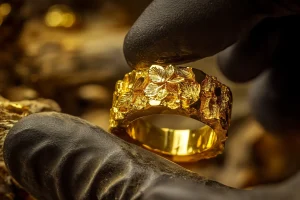 The items on this list are largely defined by their potential for two primary damaging mechanisms: chemical attack (corroding or discoloring the metal or gems) and physical abrasion (scratching the metal or gems).
The items on this list are largely defined by their potential for two primary damaging mechanisms: chemical attack (corroding or discoloring the metal or gems) and physical abrasion (scratching the metal or gems).
- Chlorine Bleach & Products Containing Chlorine: These are extremely corrosive and can permanently damage and discolor gold, particularly gold alloys. Chlorine can weaken the metal’s structure over time.
- Abrasive Cleaners & Materials:
- Toothpaste: Contains fine abrasive particles (Mohs hardness of ~3-4, which is harder than gold and silver ) that will scratch the surface of gold and can damage softer gemstones. The chemicals in toothpaste can also be corrosive.
- Scouring Powders, Steel Wool, Stiff-Bristled Brushes, Abrasive Paper Towels: All of these will inevitably scratch the surface of gold, diminishing its shine and potentially damaging delicate details or gemstones.
- Harsh Chemical Solvents & Unspecified Household Cleaners: Many general household cleaners contain unknown or aggressive ingredients that can react negatively with gold alloys or harm sensitive gemstones.
- Soaps with Unknown or Harsh Ingredients: These can leave dulling residues or cause adverse chemical reactions with the metal or stones.
- Lemon Juice / Undiluted Vinegar (for most gold jewelry, especially with gems or plating): The acidity of these substances can damage porous gemstones, pearls, and the thin layer of gold on plated jewelry. They may also affect certain base metals if the plating is compromised.
7. Ultrasonic Cleaners at Home: Proceed with Extreme Caution
Ultrasonic cleaners have become increasingly popular for home use, promising a deep clean for various items, including jewelry. However, their application to gold jewelry, especially pieces with gemstones, requires significant understanding and extreme caution.
How Ultrasonic Cleaners Work
Ultrasonic cleaners operate by using high-frequency sound waves, typically between 20 to 400 kHz, to generate cavitation bubbles in a liquid cleaning solution. These microscopic bubbles rapidly form and implode upon contact with the submerged item. This implosion creates tiny but powerful shockwaves and agitation that effectively dislodge dirt, oils, grime, and other contaminants from surfaces, including intricate details and hard-to-reach crevices of jewelry.
Potential Effectiveness for Plain, Robust Gold Items
For plain, solid gold jewelry without gemstones, or pieces set only with very securely set, durable stones like diamonds (that are not fracture-filled or heavily included), an ultrasonic cleaner can be an effective cleaning tool. Customer reviews for home ultrasonic units often report good results for general jewelry cleaning. The process can remove accumulated debris more thoroughly than manual scrubbing in some cases.
Significant Risks and Contraindications
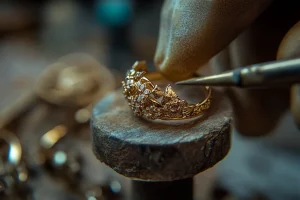 Despite their cleaning power, the very mechanism that makes ultrasonic cleaners effective—the intense vibrations and cavitation—also poses significant risks to many types of gold jewelry. The primary danger of home ultrasonic cleaners often lies not in their inability to clean, but in the user’s potential lack of expertise to discern which jewelry items are genuinely safe for this aggressive cleaning method.
Despite their cleaning power, the very mechanism that makes ultrasonic cleaners effective—the intense vibrations and cavitation—also poses significant risks to many types of gold jewelry. The primary danger of home ultrasonic cleaners often lies not in their inability to clean, but in the user’s potential lack of expertise to discern which jewelry items are genuinely safe for this aggressive cleaning method.
- GIA Cautions: The Gemological Institute of America (GIA), a leading authority, advises against the casual home use of ultrasonic cleaners for many gemstones and recommends professional assessment before subjecting jewelry to this process. provides an extensive list from GIA of gemstones that should not be cleaned in an ultrasonic machine. This includes gems with surface-reaching breaks that have been filled (like some diamonds and many emeralds), pearls, coral, ivory, shell cameos, jet, amber, gems coated with oil/plastic/wax (emeralds, lapis lazuli, malachite, opals), heat-treated gems if the treatment makes them sensitive, and gems susceptible to heat and temperature changes (tanzanite, feldspar, fluorite, iolite, kunzite, lapis lazuli, malachite, opal, topaz, turquoise, zircon).
- Loose Stones & Delicate Settings: The vibrations can easily loosen or even dislodge gemstones from their settings. This is particularly true for stones in pavé settings, channel settings, illusion settings, or any delicate antique settings where prongs may be worn or adhesives might have been used historically. Even if stones don’t fall out immediately, the setting can be weakened.
- Porous Gemstones: Organic gems like pearls and coral, and porous stones such as opals, turquoise, lapis lazuli, and malachite, can be severely damaged. They may absorb the cleaning solution, leading to discoloration, internal damage, cracking, or a permanent loss of luster.
- Treated Gemstones: Many gemstones are treated to enhance their appearance (e.g., oiling in emeralds, fracture-filling in diamonds or rubies, coatings, dyeing, or waxing). Ultrasonic cleaning can damage or completely remove these treatments, drastically altering the gem’s appearance and potentially its value.
- Heat-Sensitive Gemstones: Some ultrasonic cleaners can generate heat in the cleaning solution. This heat can be detrimental to gemstones that are sensitive to temperature changes, such as tanzanite, iolite, kunzite, some varieties of topaz, and zircon, potentially causing color changes or fractures.
- Included Gemstones: Gemstones with significant internal fractures, feathers, or inclusions (very common in emeralds, for example) can be weakened or even shattered by the ultrasonic vibrations, as these vibrations can exploit existing points of weakness.
- Plated Jewelry: Gold-plated or other metal-plated jewelry should not be placed in an ultrasonic cleaner, as the vibrations can erode or chip away the thin plating.
- Antique Jewelry: Antique pieces are often too fragile due to their age, delicate craftsmanship, or the types of settings and adhesives used in their construction. Ultrasonic cleaning can cause irreparable damage.
The marketing of home ultrasonic cleaners may inadvertently lead consumers to believe they are universally safe for all jewelry, often highlighting versatility for items like eyeglasses, rings, and dentures. While some product descriptions include fine print warnings , the overall impression can be one of broad applicability. This contrasts sharply with expert warnings about numerous contraindications.
If Using an Ultrasonic Cleaner at Home (Strongly Discouraged for Most Gem-Set or Delicate Pieces)
If, despite the risks, an ultrasonic cleaner is considered for home use:
- Restrict Use: Only use it for plain, solid gold items without any gemstones, or for pieces containing only diamonds that are known to be untreated, not significantly included, and are very securely set in robust settings. A thorough inspection for any loose stones before and after cleaning is absolutely essential.
- Correct Solution: Use a cleaning solution specifically formulated for use in ultrasonic cleaners and designated as safe for the specific metals and (if applicable) gemstones being cleaned. Do not use flammable solutions or harsh solvents.
- Follow Instructions: Adhere meticulously to the ultrasonic cleaner manufacturer’s instructions regarding solution levels, cleaning times, and temperature settings (if applicable).
- Minimize Time: Do not over-clean. Short cleaning cycles are generally safer.
- Avoid Overcrowding: Do not place too many items in the cleaner at once, as they can scratch each other.
Given the potential for irreversible damage and the average home user’s lack of gemological expertise to accurately assess risks, the safest approach for most gold jewelry, especially pieces with gemstones, is to avoid home ultrasonic cleaning and opt for gentler manual methods or professional cleaning.
8. The Professional Touch: When and Why to Entrust Your Gold Jewelry to an Expert
While diligent at-home cleaning can maintain the day-to-day sparkle of your gold jewelry, there are times when the expertise and specialized equipment of a professional jeweler are indispensable. Recognizing these instances is key to the long-term preservation and beauty of your cherished pieces. Professional jewelry servicing is not just about “cleaning”; it often encompasses a holistic “health check” for your jewelry, offering diagnostic and preventative benefits that are simply unattainable with home methods.
Identifying the Need: Signs Home Cleaning Isn’t Enough
It’s time to consult a professional jeweler when you encounter the following:
- Deep-Seated Grime & Stubborn Tarnish: If routine home cleaning with mild soap and water fails to restore your jewelry’s luster or remove persistent discoloration and tarnish, professionals have stronger yet safe methods to tackle this.
- Visible Scratches or Overall Dullness: When the surface of the gold itself appears scratched, abraded, or has lost its reflective polish, home methods cannot restore this. Professional buffing and polishing are required.
- Loose or Damaged Settings/Stones: This is a critical indicator. If you notice any loose prongs, settings that appear worn, or if gemstones feel wobbly or have shifted, cease wearing the piece and take it to a jeweler immediately. Attempting to clean jewelry with loose stones can lead to their loss.
- Concerns about Delicate, Valuable, or Antique Pieces: If you own antique jewelry, pieces with very delicate or porous gemstones (such as pearls, opals, emeralds, turquoise), or items of significant sentimental or monetary value, and you are unsure about the safest cleaning approach, professional care is the wisest choice.
- Need for Specialized Services: Certain maintenance tasks, most notably rhodium re-plating for white gold, can only be performed professionally.
The Advantages of Professional Services
 Professional jewelers offer a range of benefits that go far beyond what can be achieved at home:
Professional jewelers offer a range of benefits that go far beyond what can be achieved at home:
- Expertise and Experience: Jewelers are trained gemologists and metalsmiths. They can accurately identify different metals, gemstones (including their treatments and potential vulnerabilities), and apply the most appropriate and safe cleaning and maintenance techniques for each specific piece. They can often spot subtle issues, like hairline cracks or early signs of wear, that an untrained eye would miss.
- Specialized Equipment & Techniques:
- High-Powered Ultrasonic Baths: Professionals use industrial-grade ultrasonic cleaners with precisely formulated cleaning solutions. Crucially, they have the expertise to know which jewelry items can be safely cleaned using this method and which cannot.
- Steam Cleaners: High-pressure steam cleaning is another common professional method. It effectively removes grease, oils, and grime, and also sanitizes the jewelry. However, like ultrasonic cleaning, it’s not suitable for all gemstones (e.g., opals, pearls, many treated stones).
- Professional Polishing and Buffing: Jewelers use specialized polishing wheels, compounds, and techniques to remove scratches from the metal surface and restore its original high shine and luster. This process carefully removes a minuscule amount of metal and cannot be replicated safely or effectively at home.
- Thorough Inspection: Perhaps one of the most valuable aspects of professional servicing is the comprehensive inspection that typically accompanies cleaning. Jewelers examine pieces under magnification to check for wear and tear, loose stones, worn or bent prongs, the integrity of clasps, and other potential structural issues. Catching these problems early can prevent more costly repairs or the loss of a gemstone later on. This preventative maintenance is invaluable.
- Safe Handling of Delicate & Treated Gemstones: Professionals possess the specific knowledge required to safely clean delicate, porous, or treated gemstones without causing damage to the stone or compromising its treatment.
- Rhodium Re-plating for White Gold: White gold jewelry requires periodic re-plating with rhodium to maintain its bright white, reflective finish, as the original plating wears away over time. This electroplating process involves thoroughly cleaning the jewelry and then applying a new, thin layer of rhodium. The benefits are numerous: it enhances the aesthetic appearance (bright white shine), provides a protective coating against scratches and tarnish, increases durability, and offers a hypoallergenic surface. This specialized service can only be performed by a professional jeweler and fundamentally positions white gold as a material requiring ongoing professional maintenance, unlike yellow or rose gold which primarily need polishing to restore shine.
- Preservation of Value: Regular professional care, including cleaning, inspection, and timely repairs, helps maintain the jewelry’s optimal condition, appearance, and thus its monetary and sentimental value over the long term.
The limitations of home cleaning methods, especially for complex pieces, stubborn issues, or specialized needs like polishing and re-plating, naturally create the “value proposition” for professional services. The gap between what can be safely and effectively achieved at home and what is necessary for full restoration or complex care is precisely where professional jewelers offer their indispensable expertise and equipment.
Recommended Frequency for Professional Check-ups and Cleaning
For most gold jewelry, a professional check-up and cleaning is recommended at least once a year. However, for pieces that are worn regularly (like engagement rings), are antique or heirloom items, are subjected to an active lifestyle, or feature softer or more delicate gemstones such as opals or emeralds, more frequent visits—perhaps twice a year or as needed—are advisable.
9. Conclusion: Balancing Home Care with Professional Expertise
Safely cleaning gold jewelry at home is an achievable and rewarding practice that helps maintain its beauty and longevity. The cornerstone of effective home care lies in understanding the specific nature of your gold—its karat, color, and whether it is solid, filled, or plated—and recognizing the unique needs of any accompanying gemstones. The overwhelming consensus points towards a gentle approach: using a simple solution of warm water and a few drops of mild, phosphate-free dish soap, combined with a soft-bristled toothbrush for delicate scrubbing and a lint-free cloth for thorough drying, is the safest and most effective method for most gold pieces.
Crucially, awareness of what to avoid is as important as knowing what to use. Harsh chemicals like chlorine bleach and ammonia, abrasive substances such as toothpaste and baking soda, and extreme temperatures like boiling water can cause irreversible damage to gold and many gemstones. Similarly, while home ultrasonic cleaners may seem convenient, they pose significant risks to jewelry with porous or treated gemstones, delicate settings, or antique construction, making them unsuitable for most gem-set pieces without expert assessment.
Proactive care, including proper storage and removing jewelry during potentially damaging activities, further minimizes wear and the need for intensive cleaning. However, home cleaning has its limitations. For deep-seated grime, stubborn tarnish, visible scratches, loose settings, or the specialized care required by many delicate gemstones and all white gold (for rhodium re-plating), the expertise and equipment of a professional jeweler are indispensable. Regular professional check-ups, ideally once or twice a year, not only restore your jewelry to its full brilliance but also provide vital inspections that can prevent costly damage or loss.
By combining diligent, gentle home care with the periodic intervention of professional expertise, you can ensure that your gold jewelry—whether a contemporary adornment or a cherished heirloom—continues to radiate its timeless beauty and sentimental value for generations to come.




